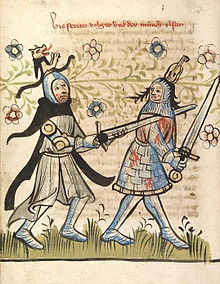Surcoat


A surcoat or surcote is an outer garment that was commonly worn in the Middle Ages by soldiers. It was worn over armor to show insignia and help identify what side the soldier was on. In the battlefield the surcoat was also helpful with keeping the sun off the soldier and their armor which helped prevent heat stroke and heat exhaustion. The name derives from French meaning "over the coat", a long, loose, often sleeveless coat reaching down to the feet.[1]
History
Men's surcoat
From about the late 12th century,
In the 15th century, once suits of plate armour became common, the surcoat was phased out of use. This period in the history of armour development, in which surcoats became increasingly rare, is referred to as the "surcoatless period" (1420-1485).
Women's surcoat
Women began wearing surcoats during the 13th century, both with and without sleeves.[3] A particular style, known as the sideless surcoat, developed as a fashion in the 14th century. This was a sleeveless, floor-length garment featuring exaggerated armholes, which at their most extreme were open from shoulder to hip, revealing the gown underneath. The narrow strip covering the torso, known as the plackard,[4] was usually no more than a foot wide. The style drew criticism from some moralists, who thought the garment drew an inappropriate amount of attention to the female body.[3] Despite this, sideless surcoats continued to be worn as ceremonial dress well into the 15th century, long after they had ceased to be fashionable. Some estimates place them being worn as state apparel as late as 1525.[4]
Gallery
-
c. 1300-1310
-
An early example of a sideless surcoat, c. 1325-1335
-
A sideless surcoat with gaping armholes, late 14th century
-
Sideless surcoat edged with ermine, c. 1460
-
A furred, embellished surcoat worn for ceremonial purposes, 1489-1499
See also
Footnotes
- ^ Nunn, pp. 14, 23, 24, 28
- ^ Farr, E.; et al. (1873). The National History of England. Vol. 1. London & Glasgow: William Collins, Sons & Company. Retrieved 2011-04-06.
- ^ ISBN 9780786450527.
- ^ ISBN 9780857851437.
Sources
- Nunn, Joan, Fashion in costume, 1200-2000, New Amsterdam Books, 2000, ISBN 1-56663-279-X






